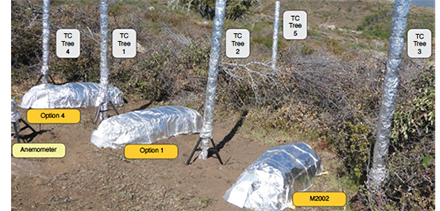A paper by Joseph Roise, John Williams, Roger Barker and John Morton-Aslanis from North Carolina State University describes a series of tests conducted to evaluate prototype fire shelters designed to provide enhanced thermal protective insulation in wildland fire burn-over events. Source: Timberbiz
Full-scale laboratory and field tests were used to compare the thermal performance of the prototypes with a fire shelter construction in current use in the United States. Laboratory tests showed that the prototype fire shelters outperformed the current shelter in providing fire-blocking thermal insulation in tests designed to simulate exposure to the intense flame conditions encountered in wildland fires.
Field tests supported laboratory comparisons but proved to be statistically inconclusive in differentiating shelter performance because of the variability inherent in thermal data obtained in field burns. This study confirmed the value of evaluating prototype shelter designs in laboratory tests capable of reproducibly simulating exposure to turbulent flames encountered in wildland fires.
This research explores the value of field-testing wildland fire shelters as a means to qualify the results from laboratory tests of fire shelter thermal protective performance. The basic assumption of the study is that the thermal conductivity of a shelter’s composite construction is constant whether measured in the laboratory or in the field.
Regardless of testing environments, the rate of heat transfer to the shelter interior is dependent on the characteristics of the heat assault and the thermal insulation provided by the shelter construction.
Variables that influence the heat transfer rates through fire shelters include the temperature difference between shelter exterior and interior, the surface area of the shelter, the material used in the shelter construction composite and the thickness of the shelter wall.
Higher temperature differences between exterior and interior of the shelter trans-late to higher rates of heat transfer. As would be expected, the lower the thermal conductivity of the shelter wall, the better the thermal protection it provides to the interior of the shelter. The exterior layer of a shelter construction is typically an aluminised fabric laminate that provides excellent reflection of incident radiant energy.
Aluminium is a metal with a high thermal conductivity, capable of reflecting radiant energy in the visible and near-infrared range of the spectrum (Pozzobon et al. 2020).
In 2000, the USDA Forest Service Missoula Technology and Development Centre (MTDC) started work to develop and test a new fire shelter design. Their goal was to maintain radiant heat protection while improving protection from direct flame exposure in burn-over events.
Many different aspects of shelter performance including material strength, durability, flammability, weight, bulk, toxicity and cost were studied. Testing procedures were developed to evaluate performance of prototype shelter materials and designs.
Using information gathered from field tests in Montana and Canada’s Northwest Territories, they found that field-testing provided valuable information on fire shelter performance. At the same time, they noted the expense, difficulty and variability of field test conditions and concluded that lab-based tests provide more repeatable and reliable information (Anderson and Petrilli 2003).
The fire shelter developed, referred to as the M2002 shelter, offered improved protection and performance in comparison with previous shelter designs.
Although the M2002 fire shelter has contributed to the safety of wildland firefighters, there is an ongoing need for new shelter designs that provide higher levels of protection from convective energy transfer caused by direct contact with flames (Interagency Fire Shelter Task Group 2007).
This laboratory-based research has shown that direct flame contact significantly degrades the thermal integrity of materials used in the construction of the M2002 fire shelter (Nagavalli et al. 2016).
The M2002 shelter construction consists of two laminated layers: an outer layer of aluminium foil laminated to a woven silica fabric combined with an inner layer of aluminium foil laminated to a woven fiberglass fabric (Nagavalli et al. 2016).
The layers utilise adhesives to laminate aluminium foil to woven fabric for each layer. The aluminium foil exterior effectively minimises radiant energy transfer through the shelter wall construction. Heat transferred in direct flame contact, however, quickly takes the bonding adhesive to its degradation temperature of 260°C (Roberts 2013), causing the structure to delaminate.
The outer aluminised layer itself fails when in contact with flames at temperatures that exceed the 660°C melting temperature of aluminium (Leitner et al. 2017). These findings
indicate the need for shelter designs that utilise robust fire-blocking layers with low thermal conductivity and stability at high temperatures.
In light of the failure mechanisms observed in the M2002 fire shelter materials, there are opportunities to develop shelter constructions that provide enhanced thermal performance by incorporating an inner convective heat-blocking barrier and additional thermal insulation into the shelter construction.
It is apparent that protocols and well-defined performance criteria for field and full-scale laboratory testing of fire shelters in conditions experienced by wildland firefighters are required to continue the improvement of shelter design and evaluation beyond the M2002 design.
This paper describes research that has attempted to fill some of the knowledge gap by exploring the relationship between a full-scale laboratory test procedure and field-testing for com- paring prototype fire shelters designed to exceed the thermal insulation performance of the M2002 shelter.
The paper is available here.






